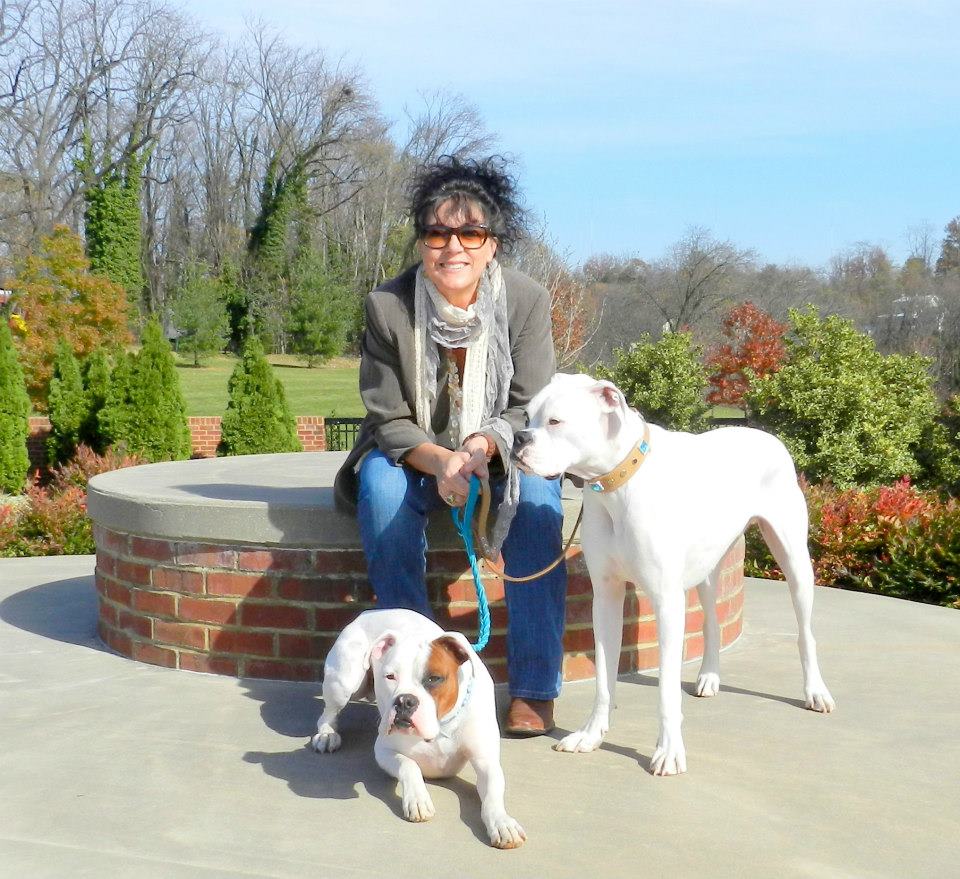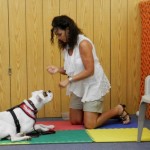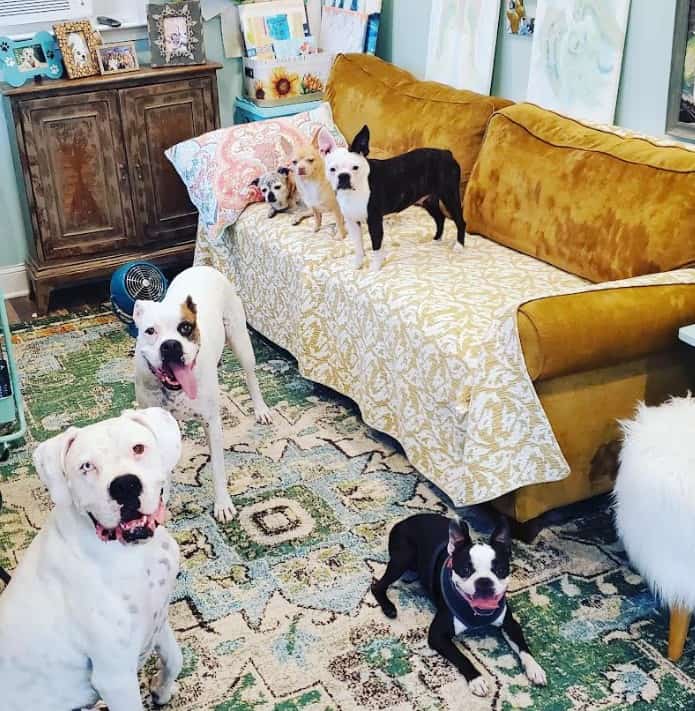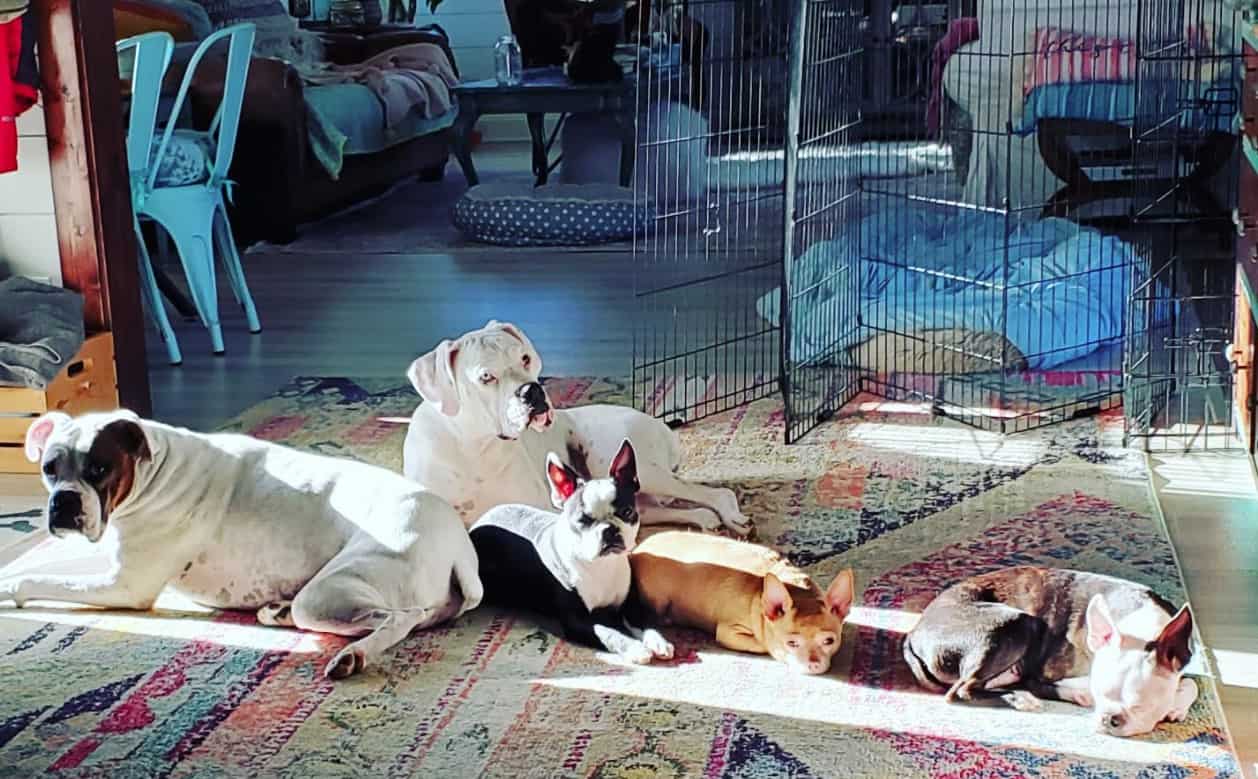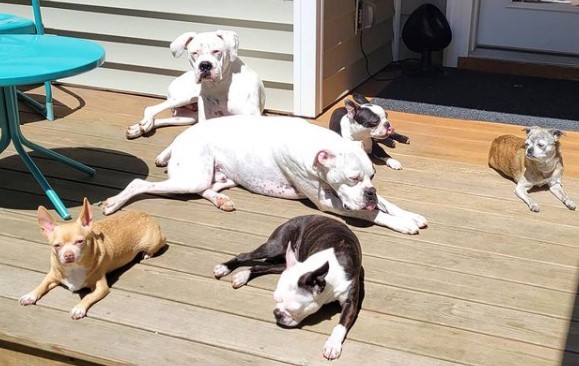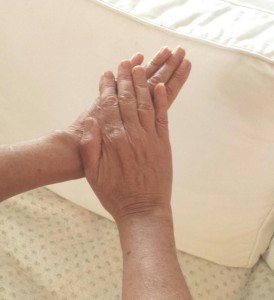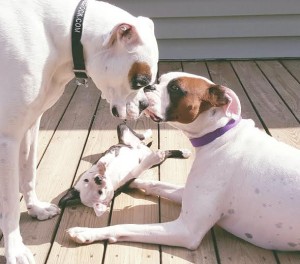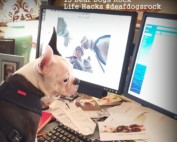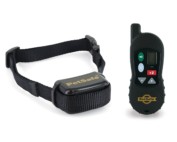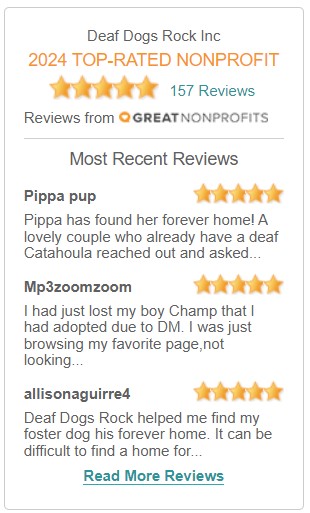When it comes to training deaf dogs, they can learn just as well as hearing dogs with just a slight tweak in the training program. When training a hearing dog, you would use verbal and visual cues. When training a deaf dog, you would use hand signs for visual cues to replace verbal cues (although I still talk so my deaf dogs can read my facial expressions). Many trainers of hearing and deaf dogs combine the verbal with facial expressions along with the visual hand signals so that both hearing and deaf dogs will perform with hand signs. Using both verbal and sign cues also helps hearing dogs later in life when they go deaf to make a much easier transition. My hearing Chug Tallulah recently became profoundly deaf and I don’t even know how long she has been that way because she follows sign direction so well.
Photo above: My sweet 13 year old Chug Tallulah who recently went deaf but since she was raised with deaf dogs and me signing all the time her deafness has not effected her at all with the exception of she no longer hears thunder storms our gunshots from the hunters in our reserve.
My deaf dogs Bud and Nitro in 2013
Below are a series of tips I’ve picked up during my last ten years of training all my deaf dogs starting with Nitro, Bud, Bowie, Lexi, Cornell, and Tallulah. I hope these tips help our readers discover how easy and enjoyable training deaf dogs can be especially if you commit to consistent positive reinforcement training every day.
Happy training! ~ Christina Lee – Deaf Dogs Rock
 Photo above from left to right: Axl, Tallulah, Bud, Bowie, Marshall and hearing Chihuahua Ringo
Photo above from left to right: Axl, Tallulah, Bud, Bowie, Marshall and hearing Chihuahua Ringo
Avoid surprising a deaf dog until you have the chance to work on desensitizing the dog with your touch. Deaf dogs can’t hear a person approaching from behind so it is very important to touch them gently and often. To wake a deaf dog, lightly blow on their face or touch the dog on the back leg or shoulder. I always wake up my deaf pups every morning and we have our morning ritual of me touching and rubbing them all over while they wake up and stretch. A gentle stroke to the dog’s head will not be taken as threatening, your hands will be safe, and your dog will come to recognize your touch as a welcome ritual. If you have a deaf dog that startles and snaps a good idea is to use a high value treat to softly touch your deaf dog and when he awakes startled you can give him a treat. Some people even set a treat in front of the sleeping dogs nose so the scent of the treat wakes him/her up. This way when the dog wakes up good things happen.
I touch all five of my deaf dogs all the time when they are sleeping to try to desensitize them to being woken up so they don’t usually startle. When I first adopted my deaf Boston puppy Bowie, he would snap when I would wake him up but not anymore because we worked hard to constantly touch him to desensitize him to our touch. When I wake my deaf dogs, I also spend time massaging each of them and gently rubbing the insides of their ears, rubbing their paws, and legs so they get used to being touched all over. In our AKC Canine Good Citizen and Therapy Dog Training programs we work on touching our deaf dogs but we also invite the instructors and other people to practice touching our dogs as well.
Training has to be a priority if you are going to adopt a deaf dog (or any dog for that matter). Training a dog takes time and patience but I think you will find with a deaf dog or puppy is that they learn very fast because they have no sound distractions and they are very focused on their handlers. Also when a deaf dog finally figures out what you are asking him to do, you can actually see the excitement in their eyes and facial expression. The first step in training a deaf dog is to get on a dedicated training schedule hopefully at a positive reinforcement dog training center so your deaf dog gets the socialization he/she needs for building a strong training/socialization foundation.
The second step in training a deaf dog is getting them to look at you often because a deaf dog needs to be looking at you before you can sign a specific cue to the dog. We do “watch me training” so often that all five of my deaf dogs are condition to watch me. When a deaf dog gets a sign cue, they will watch for your facial expressions to see if you have a happy look on your face so I smile a lot during my training sessions. You will find when you train a deaf dog the best course of action is learning about and using Positive Reinforcement Dog Training by using a marker and a high value treat. The second course of action is lots of praise like smiling, a thumbs up sign as your marker (instead of the sound of a clicker) and I even do a wave clap and act happy when my deaf dogs figure out what a new sign cue means. I make sure to repeat the cue, mark the right choice followed up by a high value treat. I call it repeat and treat. I always make sure the deaf dog I am working with is hungry so I do my training sessions about a half hour before their meal times. What I mean by a high value treat is a treat that is viewed as currency by your dog. I usually cut up unseasoned turkey meatballs, hot dogs or sliced light bologna.
Hand signals based on American Sign Language (ASL) work very well, or you can make up the basic signals like sit, come and stay. I use a little of both so many of us deaf dog owners call our signs Deaf Dog Sign Language or DDSL. If you have more then just your deaf dog at home (I have five deaf dogs and one hearing dog), you will be surprised how fast your hearing dogs will pick up on the DDSL hand signals when there is a high value treat involved. My deaf dogs know between 30 – 50 sign cues which include basic every day signs like “time to eat”, “time to go for a walk”, “go potty and then many trick cues. Click here to see more about “Beginning Sign Training” and to watch an video with Alisha McGraw where she shares with all of you the ASL signs for the most common dog command signs.
Photo above: Deaf Dogs Bud, Bowie, Marshall, Tallulah, unilaterally deaf dog Axl Blu and hearing dog Ringo (chihuahua).
If you want to use ASL for signing be sure to check out aslpro.com or signsavvy.com to learn the different hand signs for different cues for your deaf dog. An advantage to using ASL sign is if the dog you are teaching is in a shelter and up for adoption it helps the new family to be able to have a consistent easy sign language they can look up on-line. Also I can’t count the times a deaf person has come up to Nitro and asked him for a “sit” in ASL and he immediately sits down. He is such a good boy!
When I give my deaf dogs a sign cue, and they follow through and do the sign cue, I make sure to smile, give them a thumbs up sign (just like in clicker training but instead of a the sound of a clicker the dogs see a visual marker in place of the clicker). What I am trying to do when I do a marker is to mark the correct behavior the very second the dog chooses to make the right choice when given a specific sign cue. For example for “sit” I lure the deaf dog into place by holding a treat over the dog’s head, when the dog sits, I immediately give a thumbs up sign followed by a treat. What this does is let the deaf dog know after just a couple of repetitions is that he/she is doing the correct action to my sign cue request. It is very important to mention to everyone to never use a flashlight, LED light or a laser light or a vibration collar as a marker (see our posts on OCD behaviors and light). Lights can trigger extreme OCD behaviors where the dog will always be searching for the light (shadow pouncing, digging at the ground and never looking up to make eye contact). View more about how to get started with Marker Training here.
Teach your dog focus. Always make sure to teach your dog to focus on you as the dog’s handler and constantly “check in” with you every few seconds. You can teach your dog the “watch me” sign by holding the treat up by your eyes or nose and say “watch me” by pointing to your eyes. Deaf dogs are visually oriented, so use visual cues and body language. My deaf dogs had a huge training advantage in their levels obedience classes because while the other dogs were barking and being disruptive, my deaf dogs were totally focused on me in most of my classes. Nitro for example went through puppy class all the way to level 4 in six weeks and he is 100% deaf!
Trust is everything to a deaf dog. All five of my deaf dogs know no matter what happens I always have theirs backs. For this reason, in my opinion, you must never ever strike your deaf dog for any reason but instead redirect him. They need to trust your hands 100% as positive communication tools. Your hands are your bridge to everything you do with and for your deaf dog. Redirection is always the best course of action for example if your deaf dog is chewing on your shoes, you would give your deaf dog the “drop” sign, remove the shoes and then give the dog a chew toy with a “thumbs up” sign. When your deaf dog is truly bonded with you, he will always come to you if he is worried or frightened. At our local dog park my deaf dog Bud is more of a free spirit and runs with the pack but Nitro used to shadow me everywhere I went (he passed in 2018).
Make dog training part of every activity you do throughout your day. My first few weeks with each one of my deaf dogs Nitro, Bud, Bowie and Marshall, I had them attached to my belt by a leash. We call this Tether Training. To learn more about Tether Training, please click here. All three deaf dogs literally became my shadow. I use this time as an opportunity to sign to them, point and treat to give them directional training.
By the end of the week of tether training, they know about 20 signs right off the bat. Now they both move from room to room with me when I am in the house. Deaf dogs have a good chance of having separation anxiety issues so they tend to follow their owners from room to room. For the first two years of having Nitro and Bud they used to follow me from room to room but not as much anymore. My deaf puppy Marshall now follows me from room to room but I can see lately he is getting more independent. If your deaf dog is being good and just hanging out on the floor watching you then give him a treat with a thumbs up for being a “good dog”. By being consistent and doing these training tips often, you will be amazed at the transformation from an unruly young dog to a dog with good canine manners who actually pays attention to your commands.
Deaf dogs can be great with children. My dogs Bowie and Marshall absolutely love children and they are trained to sit or lay all the way down when they meet a new child or another dog. Since children can be unpredictable, raising a deaf dog in a household with children can take extra training not just for the dog but also for the children. On the other hand my deaf dog Bud who just turned three is nervous around kids so we have to go a little slower with introductions with him.
Children must be taught to respect the dog’s space and not to disrupt the deaf dog when he is sleeping. Also playing a serious game of Tug of War with a deaf dog is a big mistake if you have small children. You don’t want a deaf dog chasing children and grabbing onto their clothing (and tugging) them in play so it is important to show the children how to teach a dog to fetch by taking two toys (throw one and when the dog comes back to them throw the other toy which makes him drop the first and go after the second) and teach the dog to fetch so he is running after the toy and not the kids.
Photo above: Nitro training in public. He loved children so much that when he saw a child, he would lay down, put his head on the ground, look sad so they would come over and see him. He just adored children and he was always so gentle. In his early puppy training and obedience training he learned to sit when a stranger approached but he took it upon himself to lay down for children.
Deaf dogs can’t hear an adult or child cry out in pain when a puppy bites down to hard so it is important to work on bite inhibition and leave it training. I have taught all my deaf pups the “no bite” sign cue.
When a deaf dog bites, you should give the “no bite” sign, make a very sad facial expression and make sure all play abruptly stops by walking away. Repeat, repeat, repeat. This also includes playing with other dogs, children and adults. As soon as the dog learns when he/she bites down to hard, all play stops, then they learn very fast not to bite down hard. I have also taught my deaf dog the “gentle” sign by softly stroking the top of my hand with my other hand and mouthing the word “gentle”.
Give a deaf dog his own personal and safe space. Be sure to have an area where the deaf dog can have his very own space. For my deaf dogs they both have big kennels in our bedroom that are half covered up with blankets so each kennel is like a big den for each dog. This is a safe place they each can go inside and get their time to relax and take a nap. We have crate trained all of our dogs and we give them their meals and treats in their crates so their crates are a positive place to go.
If you are getting a deaf puppy or a rambunctious older deaf dog, think about putting up doggy gates in your living-family room. By having dog gates up, you can monitor your dog when you are potty training and from keeping them from counter. Young dogs love to get into everything so it helps to visually see your deaf dog at all times. Also never punish a deaf dog by putting him into his crate. The crate must always be a positive place to go so never use it as your “time out” area. If you need a “time out” place then choose one like a hallway with a gate up and stick to it (some folks use a hallway or outside in the back yard).
[easyazon_link identifier=”B01BTYXGPG” locale=”US” tag=”deafdogsrock-20″]see the Safety First Extra Tall and Wide Gate on Amazon[/easyazon_link]
[easyazon_link identifier=”B009YDFX2Y” locale=”US” tag=”deafdogsrock-20″]see the Safety First Perfect Fit gate on Amazon[/easyazon_link]
In my opinion, having a fenced yard is a life saver when living with a deaf dog unless you can take your dog on a lot of walks, go to doggy daycare or go to a safe dog park. A smaller lap dog will do well because they are happy just taking a walk a couple of times a day. You must always walk a deaf dog on a leash. If you decide you want a deaf dog who can be off leash, (many compete in agility, rally, flyball and disc competitions) then it would be a good idea to train your dog on recall training and introduce a vibration collar once your recall training is going well.
Hearing dogs can be your deaf dog’s “partner” My one hearing dog Ringo is a great partner for my five deaf dogs. Deaf dogs often take “cues” from the hearing dogs around them. Also my hearing dog Ringo has been trained to come whenever I call him so when he comes running to me, the other five usually follow him. You should be working on your recall with all your dogs but especially your deaf dogs. The commands of “come” and “stay” are very important and both of those commands could potentially save your deaf and hearing dog’s life one day. You can use a your porch lights and flip them on and off at night to get the dogs to come inside. I taught all my dogs the “treat” sign. If I stand under the light and show them the sign for “treat” it is like a flash mob of all six of my dogs come rushing to the back door to greet me.
I hope these tips help you on your road to building a great training foundation for your deaf dog. ~ Christina Lee – Deaf Dogs Rock


